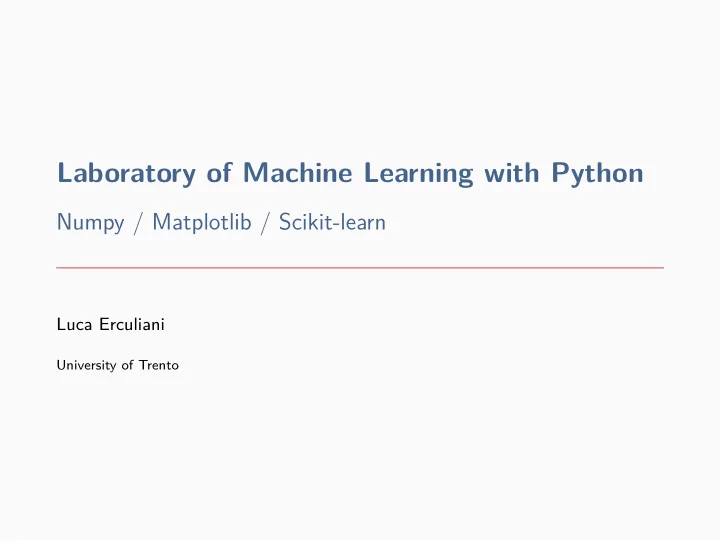

Laboratory of Machine Learning with Python Numpy / Matplotlib / Scikit-learn Luca Erculiani University of Trento
Setup (on lab machines) Download and extract the Scikit-learn lecture material from: http://disi.unitn.it/˜passerini/teaching/2018-2019/MachineLearning/ Open the terminal in the folder containing the extracted archive and run: $> ./jupyter-scikit.sh 1
Setup (on your own machine) Make sure you are using Python 3 for the following steps. Install Numpy, Scipy, Matplotlib, Scikit-learn and Jupyter: $> pip install numpy scipy matplotlib sklearn jupyter Download and extract the material for the Scikit-learn lab: http://disi.unitn.it/˜passerini/teaching/2018-2019/MachineLearning/ Open the terminal in the folder containing the extracted archive and run: $> jupyter notebook 2
Setup: Jupyther notebook Open the browser at the given address and you’ll see something like: Open the sklearn-lab.ipynb file containing the lecture notebook. 3
Setup: Jupyther notebook Execute commands by selecting a cell and clicking the Run button on the header of the page or by Shift+Enter . You will see the output of the command just below the cell. You can tweak and modify the code as you wish and execute it again. 4
Assignment For the second Machine Learning assignment you will solve a classification task using Scikit-learn over some given dataset. Each available dataset is already split into training and test sets. Your task is to choose a dataset, train a classifier on the training set and predict the labels on the test set. To pass the assignment, your classifier has to classify the examples in the test set with higher accuracy than the reference baseline for the chosen dataset. Additionally, you need to test your algorithm via cross-validation over the training set and produce a report containing the results obtained. 5
Assignment — Datasets Spambase OCR Optical Character Recognition Spam email classification Presidential campaign tweets Classification of tweets from D. Trump and H. Clinton 6
Assignment — Material Download the assignment material: http://disi.unitn.it/˜passerini/teaching/2017-2018/MachineLearning/ The material contains the three datasets, each one containing: • The training set examples; • The training set labels; • The test set examples; • The test set labels; • A README containing info about the dataset. this file also contains the reference baseline accuracy; • Other info files. 7
Assignment — Step-by-step 1. Choose a dataset; 2. Experiment with a classification algorithm of your choosing; 3. Test your classifier using cross-validation over the training set 4. Train your classifier over the full training set; 5. Use the classifier to predict the examples in the test set; 6. Place the labels in a file, in the same order as you read the test examples and in the same format of the labels in the training set. 7. Write a report describing the learning algorithm used and discussing the results obtained; The report should contain at least: • The average precision, recall, and F 1 over the cross validation folds and over the test set. Using cross val score you can specify ’precision’ , ’recall’ and ’f1’ for the scoring parameter. For the OCR dataset, in which you do multiclass classification, use weighted averaging, i.e. using ’precision weighted’ , ’recall weighted’ and ’f1 weighted’ ; • The plot of the learning curve, as shown in the lecture; 8
Assignment — Submit • After completing the assignment submit it via email • Send an email to mllab@unitn.it • Subject: sklearnSubmit2018 • Attachment: id name surname.zip containing: • The text file, named test-pred.txt , containing the final predictions; • The code used to produce the predictions, the results and the plots; • The report in PDF format. NOTE • No group work • This assignment is mandatory in order to enroll to the oral exam 9
Recommend
More recommend